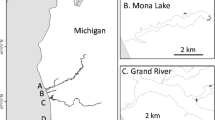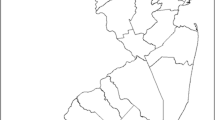Abstract
Snapping turtles (Chelydra serpentina) were collected from a brackish-water and a nearly freshwater area in the contaminated Hackensack Meadowlands of New Jersey and an uncontaminated freshwater area in Maryland to determine the effects of environmental contaminants on a resident wetland species. No turtles were observed or caught in the Meadowlands at two trapping sites that were the most heavily contaminated by metals. Snapping turtles from the brackish-water area had an unusually low lipid content of body fat and reduced growth compared to turtles from the fresh-water areas in New Jersey and Maryland. Despite the serious metal contamination of the Hackensack Meadowlands, the metal content of kidneys and livers from New Jersey turtles was low and not greatly different from that of the Maryland turtles. Organochlorine pesticide concentrations in body fat were generally low at all three study areas. Polychlorinated biphenyls (PCBs) concentrations in fat were highest in male turtles from the New Jersey brackish-water area. Analysis of blood for amino-levulinic acid dehydratase, albumin, glucose, hemoglobin, osmolality, packed cell volume, total protein, triglycerides, and uric acid failed to reveal any differences among groups that would indicate physiological impairment related to contaminants.
Similar content being viewed by others
References
Bartlett MS (1937) Properties of sufficiency and statistical tests. Proc Roy Soc A160:268–282
Beresford WA, Donovan JM, Henninger JM, Waalkes MP (1981) Lead in bone and soft tissues of box turtles caught near smelters. Bull Environ Contam Toxicol 27:349–352
Breteler RJ, Valiela I, Teal JM (1981) Bioavailability of mercury in several north-eastern U.S.Spartina ecosystems. Estuarine Coastal Shelf Sci 12:155–166
Buchet JP, Roels H, Hubermont O, Lauwerys R (1976) Effect of lead on some parameters of the heme biosynthetic pathway in rat tissuesin vivo. Toxicol 6:21–34
Cairns J, Jr. (1974) Indicator species vs the concept of community structure as an index of pollution. Water Res Bull 10:338–347
Chmiel KM, Harrison RM (1981) Lead content of small mammals at a roadside site in relation to the pathways of exposure. Sci Total Environ 17:145–154
Christiansen JL, Burken RR (1979) Growth and maturity of the snapping turtle (Chelydra serpentina) in Iowa. Herpetologica 35:261–266
Clark DR, Lamont TG (1976) Organochlorine residues and reproduction in the big brown bat. J Wildl Manage 40:249–254
Coles EH (1980) Veterinary clinical pathology. Third edition, WB Saunders Co, Philadelphia, PA
Cromartie E, Reichel WL, Locke LN, Belisle AA, Kaiser TE, Lamont TG, Mulhern BM, Prouty RM, Swineford DM (1975) Residues of Organochlorine pesticides and polychlorinated biphenyls and autopsy data for bald eagles, 1971-72. Pestic Monit J 9:11–14
Dessauer HC (1970) Blood chemistry of reptiles. In: Gans C (ed) Biology of the reptiles, Vol 3, Morphology C. Academic Press, New York, pp 1–72
— (1974) Plasma proteins of reptiles. In: Florkin M, Scheer BT (eds) Chemical zoology, Vol IX, Amphibia and Reptilia. Academic Press, New York, pp 187–216
Dieter MP, Finley MT (1979) δ-Aminolevulinic acid dehydratase enzyme activity in blood, brain, and liver of lead-dosed ducks. Environ Res 19:127–135
Eastin WC, Hoffman DJ Jr, O'Leary CT (1983) Lead accumulation and depression of δ-aminolevulinic acid dehydratase (ALAD) in young birds fed automotive waste oil. Arch Environ Contam Toxicol 12:31–35
Essink K (1980) Mercury pollution in the Ems estuary. Helgolander Meeresunters 33:111–121
Fleming WJ, McLane MAR, Cromartie E (1982) Endrin decreases screech owl productivity. J Wildl Manage 46:462–468
Fox GA, Gilman AP, Peakall DB, Anderka FW (1978) Behavioral abnormalities of nesting Lake Ontario herring gulls. J Wildl Manage 42:477–483
Galluzzi P (1981) Mercury concentrations in mammals, reptiles, birds, and waterfowl collected in the Hackensack Meadowlands, New Jersey. In: New Jersey Academy of Sciences. Rutgers University, Piscataway, NJ, pp 1–24
Galluzzi P, Sabounjian E (1980) The distribution of mercury contamination in marsh sediments, channel sediments, and surface waters of the Hackensack Meadowlands, New Jersey. In: New Jersey Academy of Sciences. Rutgers University, Piscataway, NJ, pp 1–36
Gibbons JW (1968) Growth rates of the common snapping turtleChelydra serpentina, in a polluted river. Herpetologica 24:266–267
Gilles-Baillien (1974) Seasonal variations in reptiles. In: Florkin M, Scheer BT (eds) Chemical zoology, Vol IX, Amphibia and Reptilia. Academic Press, New York, pp 353–376
Graham TE, Perkins RW (1976) Growth of the common snapping turtle,Chelydra s. serpentina, in a polluted marsh. Bull Maryland Herpetological Soc 12:123–125
Hackensack Meadowlands Development Commission (1980) Wetland bio-zones of the Hackensack Meadowlands: an inventory. Lyndhurst, NJ
Hall RJ (1980) Effects of environmental contaminants on reptiles: a review. Spec Sci Rep—Wildl No 228, U.S. Fish Wildl Ser, Washington, DC
Hammer DA (1969) Parameters of a marsh snapping turtle population, La Creek Refuge, South Dakota. J Wildl Manage 33:995–1005
Haseltine SD, Mulhern BM, Stafford CJ (1980) Organochlorine and heavy metal residues in black duck eggs from the Atlantic flyway, 1978. Pestic Monit J 14:53–57
Haseltine SD, Heinz GH, Reichel WL, Moore JF (1981) Organochlorine and metal residues in eggs of waterfowl nesting on islands in Lake Michigan off Door County, Wisconsin, 1977–78. Pestic Monit J 15:90–97
Helwig DD, Hora ME (1983) Polychlorinated biphenyl, mercury, and cadmium concentrations in Minnesota snapping turtles. Bull Environ Contam Toxicol 30:186–190
Kaiser TE, Reichel WL, Locke LN, Cromartie E, Krynitsky AJ, Lamont TG, Mulhern BM, Prouty RM, Stafford CJ, Swineford DM (1980) Organochlorine pesticides, PCB, PBB residues, and necropsy data for bald eagles from 29 States—1975–1977. Pestic Monit J 13:145–149
Kendall RJ, Scanlon PF (1982) Tissue lead concentrations and blood characteristics of mourning doves from southwestern Virginia. Arch Environ Contam Toxicol 11:269–272
Kiviat E (1980) A Hudson River tidemarsh snapping turtle population. In: Trans 37th NE Fish & Wildl Conf. The Wildlife Society, Bethesda, Maryland, pp 158–168
Licht P (1974) Endocrinology of reptiles. In: Florkin M, Scheer BT (eds) Chemical zoology, Vol IX, Amphibia and Reptilia. Academic Press, New York, pp 399–448
Mattson CP (1978) An ecological and resource management plan for the Hackensack meadowlands. Hackensack Meadow-lands Develop Commission, Lyndhurst, NJ
McCormick J & Assoc Inc (1978) Environmental impact statement on a multipurpose development. Proposed on a tract of land in North Bergen and Secaucus, Hackensack Meadowlands District, Hudson County, NJ. Prepared for Hartz Mountain Industries, Inc, Secaucus, NJ, 2 Vol
Meeks RL (1968) The accumulation of36Cl ring-labeled DDT in a fresh-water marsh. J Wildl Manage 32:376–398
Menasveta P, Cheevaparanapiwat V (1981) Heavy metals, organochlorine pesticides, and PCBs in green mussels, mullets, and sediments of river mouths in Thailand. Mar Pollut Bull 12:19–25
Meyerson AL, Luther GW III, Krajewski J, Hires RI (1981) Heavy metal distribution in Newark Bay sediments. Mar Pollut Bull 12:244–250
Millward GE, Herbert I (1981) The distribution of mercury in the sediments of the Plym estuary. Environ Pollut (Ser B) 2:265–274
Mouw D, Kalitis K, Anver M, Schwartz J, Constan A, Hartung R, Cohen B, Ringler D (1975) Lead. Possible toxicity in urban vs rural rats. Arch Environ Health 30:276–280
Mueller JA, Jeris JS, Anderson AR, Hughes CF (1976) Contaminant inputs to the New York Bight. NOAA Tech Memorandum ERL MESA-6. US Dept Commerce, Washington, DC
Neter J, Wasserman W (1974) Applied linear statistical models. Richard D. Erwin, Homewood, IL
Nishida H, Miyai M, Tada F, Suzuki S (1982) Computation of the index of pollution caused by heavy metals in river sediment. Environ Pollut (Ser B) 4:241–248
Obbard ME (1984) Population ecology of the common snapping turtle.Chelydra serpentina, in north-central Ontario. PhD Dissertation, University Guelph, Guelph, Ontario, Canada. Diss Abst Int B 44:3636–3637
Obbard ME, Brooks RJ (1981) A radio-telemetry and mark-recapture study of activity in the common snapping turtle,Chelydra serpentina. Copeia 3:630–637
Olafsson PG, Bryan AM, Bush B, Stone W (1983) Snapping turtles—a biological screen for PCBs. Chemosphere 12:1525–1532
Punzo F, Laveglia J, Lohr D, Dahm PA (1979) Organochlorine insecticide residues in amphibians and reptiles from Iowa and lizards from the southwestern United States. Bull Environ Contam Toxicol 21:842–848
Reeves RG, Woodham DW, Ganyard MC, Bond CA (1977) Preliminary monitoring of agricultural pesticides in a cooperative tobacco pest management project in North Carolina, 1971-first year study. Pestic Monit J 11:99–106
Robinson KM, Wells MR (1975) Retention of a single oral dose of cadmium in tissues of the softshell turtle,Trionyx spinifer. Bull Environ Contam Toxicol 14:750–752
Sexton OJ (1959) A method of estimating the age of painted turtles for use in demographic studies. Ecology 40:716–718
Smith JD, Butler ECV, Grant BR, Little GW, Millis N, Milne PJ (1981) Distribution and significance of copper, lead, zinc, and cadmium in the Corio Bay ecosystem. Aust J Mar Freshwater Res 32:151–164
Stone WB, Kiviat E, Butkas SA (1980) Toxicants in snapping turtles. New York Fish & Game J 27:39–50
Way CA, Schroeder GD (1982) Accumulation of lead and cadmium in wild populations of the commensal rat,Rattus norvegiens. Arch Environ Contam Toxicol 11:407–417
Zingde MD, Desai BN (1981) Mercury in Thana Creek, Bombay harbor. Mar Pollut Bull 12:237–241
Author information
Authors and Affiliations
Rights and permissions
About this article
Cite this article
Albers, P.H., Sileo, L. & Mulhern, B.M. Effects of environmental contaminants on snapping turtles of a tidal wetland. Arch. Environ. Contam. Toxicol. 15, 39–49 (1986). https://doi.org/10.1007/BF01055247
Received:
Revised:
Issue Date:
DOI: https://doi.org/10.1007/BF01055247




